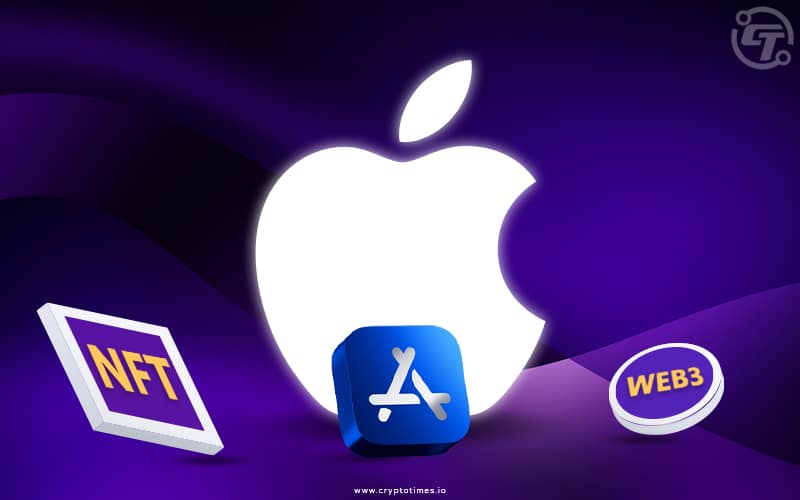On October 24th, 2022, Apple updated its app review policy along with the release of iOS 16.1 and iPadOS 16.1. In this update, Apple has detailed several restrictions on apps that involve non-fungible tokens (NFTs) and cryptocurrencies. This new guideline can definitely be considered as Apple’s most prominent, if not first, stance on Crypto, NFTs and Web 3.0.
So, what does this new policy mean for Web 3.0 developers? And how can Web3 projects break out of these restrictions? Read on to find out.
What the New Policy Says
The policy fix basically extends Apple’s existing rules regarding in-app purchases (IAP) to cover crypto assets and NFTs. In particular, Apps that comply with Apple’s policy may allow users to browse their own NFT collections or conduct related activities, including minting, listing or transferring within Apple’s ecosystem.
However, NFTs that direct customers through external links or buttons that would let them purchase services or unlock in-app features are strictly prohibited. In particular, the policy requires that all NFTs purchased through an app must be “hosted by the seller inside the app” and that the seller “must clearly describe any features or functionality” of the NFT that can be used outside of the app.
In addition, Apple stipulates that all NFT sales must go through its in-app purchase system; developers are not allowed to use alternative payment methods, such as cryptocurrency wallets, to sell NFTs. This is largely in line with Apple’s existing policies regarding in-app purchases, which restrict developers from using their own payment systems and instead require them to use their own In-App Purchase API. In this way, all transactions related to crypto assets are subject to Apple’s channel fee (30%).
Also Read: Apple allows NFT Trade via App Store, but with Massive Commission
Implications for Web3 Developers
The most immediate implication of this new policy is that NFTs are no longer meant to bypass Apple’s own in-app purchase mechanism. Apple now closes the loophole and takes complete control over various forms of crypto transactions that could happen in apps.
Worse than that, it makes many model innovations such as token-gated features, dynamic-pricing of nfts, and virtual goods auctions simply illegal because they do not comply with their IAP rules. It hurts most developers embracing web 3.0 and leaving very few rooms for their business model to work.
As @TimSweeneyEpic puts it well:
“To cryptocurrency enthusiasts, this means Apple is now adding a 30% tax on your so-called “true ownership” of digital goods.
To cryptocurrency detractors, this shows Apple’s motivations are only money. For digital items, they support NFTs they tax and ban NFTs they don’t tax.”
This could be Apple’s official stance on Crypto and NFTs. Rather than embracing them, it sees web3 as a threat to its business model and cash flow. This would make it worse for technology innovation, given how much power big companies like these have when trying out new things or changing policies without considering user benefits.
Given the company’s history of being sued against anti-steering policies and all the denunciations over the web, it’s well possible that Apple’s stance on Crypto would be pushing traders gradually to Android or for those who still want to capture IOS market share to find workarounds:
How can Web3 Projects Break Out?
So how can Web3 projects break out of their brazen rent seeking actions? Here are some of our thoughts:
Focus on Growing your own Channels:
Crypto has provided a way to align users’ interests with the project owners’ and grow communities based on consensus faster than before. Leveraging well-built web 3.0 growth channels like Quest3, Galxe or Link3, entrepreneurs with limited resources and time can easily navigate outside of walled channels by distributing the product straight through APK or Testflight Betas.
In addition, more and more projects are leveraging crypto payment options to offer customers an exciting new way to conduct IAP. The STEPN team is one such company that has developed its browser version of a marketplace where users can conduct IAP seamlessly and natively in their application.
Infrastructure providers like Mirror world that offer toolkits to allow for cheaper on-ramp and checkout experiences also have an eye on developing IAP coherent apps. This may set a new standard for dApps to follow.
Utilize other Channels:
Despite the dominating position of Apple Store in mobile entertainment, globally, there are overwhelmingly more Android devices (70% Android vs 30% iPhone). Many app stores other than Google Play do not have these restrictions, not to mention the numerous dApp stores (DappRadar, BitKeep, MirrorWorld…) where traffic has high crypto adoption rates.
Another option is to build on top of existing SDKs that have been proven to solve the compliance issue, especially on mobile. Infrastructure providers must constantly attempt to analyze the newest App Store policies, design white-labeled in-game ecosystems and come up with pre-packaged solutions for developers.
Also read: Apple Immunized from Crypto Phishing App Class Action
Conclusion:
Despite the controversies, Apple’s clarification on NFT-related policies is one important signal to the consensus that mainstream adoption of Web 3.0 applications will be the future. For developers who can stand the tax, they can now leverage Apple’s IAP to sell NFTs or offer NFT services (minting, listing, transferring). Meanwhile, crypto application adoption will either drive channel payment fees down or push new distribution channels to rise outside of Apple Store and Google Play.






